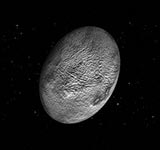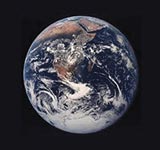The Earth is the third planet from the Sun which is the most populous planet and the fifth largest of the eight planets in the Solar System. The earth formed about 4.54 billion years ago, and life has appeared on the surface at least about 3.5 billion years ago. The Earth's biosphere then slowly changes the atmosphere and other basic physical conditions, which enable the proliferation of organisms and the formation of the ozone layer, which together with the Earth's magnetic field blocks harmful solar radiation and allows microscopic living things to multiply safely on land.
2. Saturn
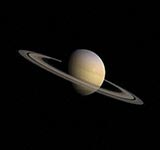
Saturn is the sixth planet in the solar system, the second in size and mass after Jupiter and the only one with a ring system visible from Earth. Its name comes from the Roman god Saturn. It is part of the so-called outer or gaseous planets. The most characteristic aspect of Saturn is its bright rings. Before the invention of the telescope, Saturn was the furthest of the known planets and, at first glance, it didn't seem bright or interesting. The first to observe the rings was Galileo in 1610, but the low inclination of the rings and the low resolution of his telescope made him think of a principle that they were large moons. Christiaan Huygens, with better means of observation, was able to observe the rings clearly in 1659. James Clerk Maxwell, in 1859, mathematically demonstrated that the rings could not be a single solid object but should be the grouping of millions of smaller particles. The particles that make up Saturn's rings spin at a speed of 48,000 km/h, 15 times faster than a bullet.
3. Uranus
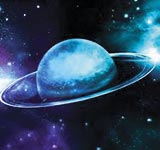
Uranus is the seventh planet in the solar system, the third largest, and the fourth most massive. It is named in honor of the Greek divinity of the sky Uranus, the father of Cronus and the grandfather of Zeus (Jupiter). Although it is detectable with the naked eye in the night sky, it was not listed as a planet by ancient astronomers due to its low luminosity and the slowness of its orbit. Sir William Herschel announced his discovery on March 13, 1781, expanding the then known boundaries of the solar system, for the first time in modern history. Uranus is also the first planet discovered by means of a telescope. Uranus is similar in composition to Neptune, and the two have a different composition from the other two gas giants (Jupiter and Saturn). Therefore, astronomers sometimes classify them in a different category, the frozen giants. The atmosphere of Uranus, although similar to that of Jupiter and Saturn because it is composed mainly of hydrogen and helium, contains a higher proportion of both ice and water, ammonia and methane, along with traces of hydrocarbons.
4. Neptune
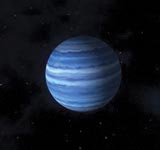
Neptune is the eighth planet in distance from the Sun and the furthest from the solar system. It is part of the outer planets or gas giants, and is the first that was discovered thanks to mathematical predictions. Its name was placed in honor of the Roman god of the sea - Neptune, and it is the fourth planet in diameter and the third largest in mass. Its mass is seventeen times that of Earth and slightly greater than that of its "twin" planet Uranus, which has fifteen land masses and it's not so dense. On average, Neptune orbits the Sun at a distance of 30.1 ua. Its astronomical symbol is ♆, a stylized version of the trident of the god Neptune. After the discovery of Uranus, it was observed that the orbits of Uranus, Saturn and Jupiter did not behave as predicted by the laws of Kepler and Newton. Adams and Le Verrier independently calculated the position of a hypothetical planet, Neptune, which was finally found by Galle, on September 23, 1846, less than a degree from the position calculated by Le Verrier. Later it was noticed that Galileo had already observed Neptune in 1612, but he had confused it with a star.
5. Mars
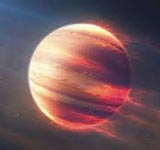
Mars is the fourth planet in order of distance from the Sun and the second smallest in the solar system, after Mercury. It was named in honor of the god of war in Roman mythology (Ares in Greek mythology), and is also known as the "Red Planet" due to the reddish appearance that gives you the iron oxide predominant on its surface. Mars is the inner planet farthest from the sun. It is a telluric planet with an atmospherethin carbon dioxide, and has two small and irregularly shaped satellites, Phobos and Deimos (children of the Greek god), which could be asteroids captured similar to the Trojan asteroid (5261) Eureka. Its superficial characteristics are reminiscent of both the craters of the Moon and the valleys, deserts and polar ice caps of Earth.
6. Jupiter
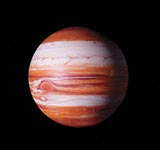
Jupiter is the fifth planet in the solar system. It is part of the so-called outer or gaseous planets. It receives its name from the Roman god Jupiter (Zeus in Greek mythology). It is the planet that offers a greater brightness throughout the year depending on its phase. It is also, after the Sun, the largest celestial body in the solar system, with a mass almost two and a half times that of the other planets together (with a mass 318 times greater than Earth's and three times greater than Saturn's, in addition to being, in terms of volume, 1317 times larger than the Earth). It is also the oldest planet in the solar system, being even older than the sun. This discovery was made by researchers from the University of Münster in Germany.
7. Eris
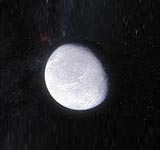
8. Pluto
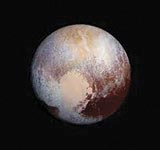
Pluto, designated (134340) Pluto, is a dwarf planet in the solar system located next to the orbit of Neptune. Its name is due to the Roman mythological god Pluto (Hades according to Greek mythology). In the General Assembly of the International Astronomical Union held in Prague on August 24, 2006, a new category called plutoid was created, which includes Pluto. It is also the prototype of a category of transneptunian objects called plutinos. Pluto has an eccentric and highly inclined orbit with respect to the ecliptic, which travels approaching in its perihelion to the interior of the orbit of Neptune. Also it has five satellites: Charon, Nix, Hydra, Cerberus and Styx, which are celestial bodies that share the same category.
9. Quaoar
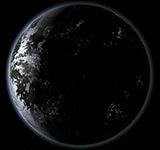
10. Makemake
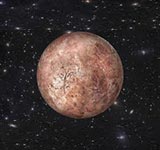
11. Mercury
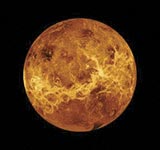
Mercury is the planet in the solar system closest to the Sun and the smallest. It is part of the so-called inner or terrestrial planets and lacks natural satellites just like Venus. Very little was known about its surface until the Mariner 10 planetary probe was sent and observations were made with radar and radio telescopes. Formerly it was thought that Mercury always presented the same face to the Sun, a situation similar to the case of the Moon with the Earth, that is, its rotation period was equal to its translation period, both 88 days. However, in 1965 radar impulses were sent to Mercury, which was definitely demonstrated that its rotation period was 58.7 days, which is 2/3 of its translation period. This is not a coincidence, and it is a situation called orbital resonance. Being a planet whose orbit is internal to that of the Earth, we observe it pass periodically in front of the Sun, a phenomenon called astronomical transit. Observations of its orbit through many years showed that the perihelion rotates 43 "arc more per century than predicted by Newton's classical mechanics.
12. Salacia
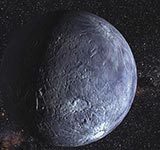
13. Ceres
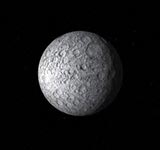
Ceres is a dwarf planet and the largest astronomical object in the asteroid belt, a region of the solar system that lies between the orbits of Mars and Jupiter. Its diameter of approximately 945 km makes it the thirty-third largest known object in the solar system. Its mass is estimated to be one third of the total mass of the asteroid belt, with the only object in the asteroid belt reaching hydrostatic equilibrium. Seen from Earth, its apparent magnitude it ranges from 6.7 to 9.3. Therefore, it is too weak to be seen with the eye except in the most favorable oppositions and under very dark skies.
14. Venus
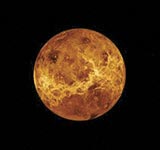
Venus is the second planet in the solar system in order of distance from the Sun, the sixth in size, ordered from highest to lowest. Like Mercury, it lacks natural satellites. It receives its name in honor of Venus, the Roman goddess of love (gr. Aphrodite). It is a rocky and terrestrial planet, often called the sister planet of the Earth, since both are similar in size, mass and composition, although totally different in thermal and atmospheric issues (the average temperature of Venus is 463.85°C). Its orbit it is an ellipse with an eccentricity of less than 1%, forming the most circular orbit of all the planets, barely exceeds that of Neptune. Its atmospheric pressure is 90 times higher than the earth. It is, therefore, the highest atmospheric pressure of all the rocky planets in the solar system.
15. Sedna
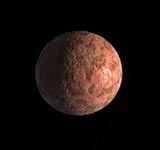
16. Trojans
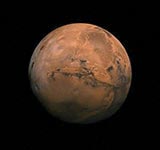
17. Orcus
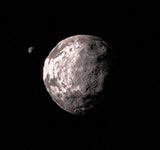
18. Haumea
